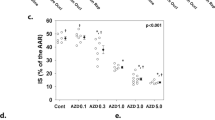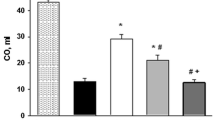Abstract
Adenosine kinase phosphorylates adenosine to AMP, the primary pathway for adenosine metabolism under basal conditions. Inhibition of adenosine kinase results in a site–specific increase in interstitial adenosine. Using a rat model of myocardial infarction, we examined the protective effects of adenosine kinase inhibition. Male Sprague–Dawley rats underwent 30 min regional occlusion followed by 90 min reperfusion. Infarct size, expressed as a percent of the area–at–risk, IS/AAR(%), was 58.0 ± 2.1 % in untreated rats. Pretreatment with the adenosine kinase inhibitor, 5–iodotubercidin (1 mg/kg), limited infarct development to 37.5±3.7% (P < 0.001). The A1 adenosine receptor (A1AR) antagonist, DPCPX (100 µg/kg), abolished the infarct–sparing effect of 5–iodotubercidin (IS, 62.8 ± 1.3%). Similarly, the A3 adenosine receptor (A3AR) antagonist, MRS–1523 (2 mg/kg), and the δ–opioid receptor (DOR) antagonist, BNTX, (1 mg/kg) abolished the reduction of IS produced by iodotubercidin. Pretreatment with the ROS scavenger, 2–MPG (20 mg/kg), or the PKC–δ antagonist, rottlerin (0.3 mg/kg) also abolished iodotubercidin–mediated cardioprotection. Furthermore, pretreatment with 5–HD, a mitochondrial KATP (mitoKATP) channel inhibitor, but not the sarcolemmal KATP channel blocker, HMR–1098, abrogated the beneficial effects of adenosine kinase inhibition (IS, 59.5 ± 3.8%). These data suggest that inhibition of adenosine kinase is effective in reducing infarct development via A1AR, A3AR and DOR activation. Data also suggest that this protection is mediated via ROS, PKC–δ and mitoKATP channels.
Similar content being viewed by others
References
Auchampach JA, Gross GJ (1993) Adenosine A1 receptors, KATP channels, and ischemic preconditioning in dogs. Am J Physiol 264:H1327–H336
Auchampach JA, Jin X, Moore J et al. (2004) Comparison of three different A1 adenosine receptor antagonists on infarct size and multiple cycle ischemic preconditioning in anesthetized dogs. J Pharmacol Exp Ther 308:846–856
Campas C, Lopez JM, Santidrian AF et al. (2003) Acadesine activates AMPK and induces apoptosis in B–cell chronic lymphocytic leukemia cells but not in T lymphocytes. Blood 101:3674–3680
Cerniway RJ, Yang Z, Jacobson MA, Linden J, Matherne GP (2001) Targeted deletion of A(3) adenosine receptors improves tolerance to ischemia–reperfusion injury in mouse myocardium. Am J Physiol Heart Circ Physiol 281: H1751–H1758
Cohen MV, Yang XM, Liu GS, Heusch G, Downey JM (2001) Acetylcholine, bradykinin, opioids, and phenylephrine, but not adenosine, trigger preconditioning by generating free radicals and opening mitochondrial KATP channels. Circ Res 89:273–278
Dubey RK, Gillespie DG, Mi Z, Jackson EK (1997) Exogenous and endogenous adenosine inhibits fetal calf seruminduced growth of rat cardiac fibroblasts: role of A2B receptors. Circulation 96:2656–2666
Fox, T, Coll JT, Xie XL et al. (1998) A single amino acid substitution makes ERK2 susceptible to pyridinyl imidazole inhibitors of p38 MAP kinase. Protein Sci 7:2249–2255
Fryer RM, Wang Y, Hsu AK, Gross GJ (2001) Essential activation of PKC–delta in opioid–initiated cardioprotection. Am J Physiol Heart Circ Physiol 280:H1346–H1353
George SR, Fan T, Xie Z et al. (2000) Oligomerization of mu– and delta–opioid receptors. Generation of novel functional properties. J Biol Chem 275:26128–26135
Gines S, Hillion J, Torvinen M et al. (2000) Dopamine D1 and adenosine A1 receptors form functionally interacting heteromeric complexes. Proc Natl Acad Sci USA 97:8606–8611
Gomes I, Jordan BA, Gupta A, Trapaidze N, Nagy V, Devi LA (2000) Heterodimerization of mu and delta opioid receptors: A role in opiate synergy. J Neurosci 20:RC110
Grover GJ, Baird AJ, Sleph PG (1996) Lack of a pharmacologic interaction between ATP–sensitive potassium channels and adenosine A1 receptors in ischemic rat hearts. Cardiovasc Res 31:511–517
Halimi G, Devaux C, Clot–Faybesse O et al. (2000) Modulation of adenosine concentration by opioid receptor agonists in rat striatum. Eur J Pharmacol 398:217–224
Hausenloy DJ, Maddock HL, Baxter GF, Yellon DM (2002) Inhibiting mitochondrial permeability transition pore opening: a new paradigm for myocardial preconditioning? Cardiovasc Res 55:534–543
Headrick JP (1996) Ischemic preconditioning: bioenergetic and metabolic changes and the role of endogenous adenosine. J Mol Cell Cardiol 28:1227–1240
Headrick JP, Gauthier NS, Morrison R, Matherne GP (2000) Cardioprotection by KATP channels in wild–type hearts and hearts overexpressing A1–adenosine receptors. Am J Physiol Heart Circ Physiol 279:H1690–H1697
Headrick JP, Hack B, Ashton KJ (2003) Acute adenosinergic cardioprotection in ischemic–reperfused hearts. Am J Physiol Heart Circ Physiol 285:H1797–H1818
Hu K, Li GR, Nattel S (1999) Adenosineinduced activation of ATP–sensitive K+ channels in excised membrane patches is mediated by PKC. Am J Physiol 276:H488–H495
Inagaki K, Chen L, Ikeno F et al. (2003) Inhibition of delta–protein kinase C protects against reperfusion injury of the ischemic heart in vivo. Circulation 108:2304–2307
Jin X, Shepherd RK, Duling BR, Linden J (1997) Inosine binds to A3 adenosine receptors and stimulates mast cell degranulation. J Clin Invest 100:2849–2857
Jordan BA, Devi LA (1999) G–proteincoupled receptor heterodimerization modulates receptor function. Nature 399:697–700
Jordan BA, Trapaidze N, Gomes I, Nivarthi R, Devi LA (2001) Oligomerization of opioid receptors with beta 2– adrenergic receptors: a role in trafficking and mitogen–activated protein kinase activation. Proc Natl Acad Sci USA 98:343–348
Kamiya T, Saitoh O, Yoshioka K, Nakata H (2003) Oligomerization of adenosine A2A and dopamine D2 receptors in living cells. Biochem Biophys Res Commun 306:544–549
Kaplan GB, Coyle TS (1998) Adenosine kinase inhibitors attenuate opiate withdrawal via adenosine receptor activation. Eur J Pharmacol 362:1–8
Kowaluk EA, Bhagwat SS, Jarvis MF (1998) Adenosine kinase inhibitors. Curr Pharm Des 4:403–416
Krenz M, Oldenburg O, Wimpee H et al. (2002) Opening of ATP–sensitive potassium channels causes generation of free radicals in vascular smooth muscle cells. Basic Res Cardiol 97:365–373
Lebuffe G, Schumacker PT, Shao ZH, Anderson T, Iwase H, Vanden Hoek TL (2003) ROS and NO trigger early preconditioning: relationship to mitochondrial KATP channel. Am J Physiol Heart Circ Physiol 284:H299–H308
Moser GH, Schrader J, Deussen A (1989) Turnover of adenosine in plasma of human and dog blood. Am J Physiol 256:C799–C806
Ohnuma Y, Miura T, Miki T et al. (2002) Opening of mitochondrial KATP channel occurs downstream of PKC–ε activation in the mechanism of preconditioning. Am J Physiol Heart Circ Physiol 283:H440–H447
Patel HH, Hsu AK, Peart JN, Gross G (2002) Sarcolemmal KATP channel triggers opioid–induced delayed cardioprotection in the rat. Circ Res 91:186–188
Peart J, Headrick JP (2000) Intrinsic A(1) adenosine receptor activation during ischemia or reperfusion improves recovery in mouse hearts. Am J Physiol Heart Circ Physiol 279:H2166–H2175
Peart J, Matherne GP, Cerniway RJ, Headrick JP (2001) Cardioprotection with adenosine metabolism inhibitors in ischemic–reperfused mouse heart. Cardiovasc Res 52:120–129
Peart J, Willems L, Headrick JP (2003) Receptor and non–receptor–dependent mechanisms of cardioprotection with adenosine. Am J Physiol Heart Circ Physiol 284:H519–H527
Peart JN, Gross GJ (2003) Adenosine and opioid receptor–mediated cardioprotection in the rat: evidence for cross–talk between receptors. Am J Physiol Heart Circ Physiol 285:H81–H89
Peralta C, Bartrons RA, Serafin A et al. (2001) Adenosine monophosphate–activated protein kinase mediates the protective effects of ischemic preconditioning on hepatic ischemia–reperfusion injury in the rat. Hepatology 34:1164–1173
Pfeiffer M, Koch T, Schroder H, Laugsch M, Hollt V, Schulz S (2002) Heterodimerization of somatostatin and opioid receptors cross–modulates phosphorylation, internalization, and desensitization. J Biol Chem 277:19762–19772
Phillis JW, O’Regan MH, Song D (1999) Further evidence for the role of adenosine in hypercapnia/acidosis–evoked coronary flow regulation. Gen Pharmacol 33:431–437
Russell, RR, III, Bergeron R, Shulman GI, Young LH (1999) Translocation of myocardial GLUT–4 and increased glucose uptake through activation of AMPK by AICAR. Am J Physiol Heart Circ Physiol 277:H643–H649
Sawynok J, Jhamandas KH (1976) Inhibition of acetylcholine release from cholinergic nerves by adenosine, adenine nucleotides and morphine: antagonism by theophylline. J Pharmacol Exp Ther 197:379–390
Shryock JC, Belardinelli L (1997) Adenosine and adenosine receptors in the cardiovascular system: biochemistry, physiology, and pharmacology. Am J Cardiol 79:2–10
Smolenski RT, Raisky O, Slominska EM, et al. (2001) Protection from reperfusion injury after cardiac transplantation by inhibition of adenosine metabolism and nucleotide precursor supply. Circulation 104:I246–I252
Sollevi A (1986) Cardiovascular effects of adenosine in man; possible clinical implications. Prog Neurobiol 27:319–349
Tracey WR, Magee W, Masamune H, Oleynek JJ, Hill RJ (1998) Selective activation of adenosine A3 receptors with N6– (3–chlorobenzyl)–5’–N–methylcarboxamidoadenosine (CB–MECA) provides cardioprotection via KATP channel activation. Cardiovasc Res 40:138–145
Uecker M, Da Silva R, Grampp T, Pasch T, Schaub MC, Zaugg M (2003) Translocation of protein kinase C isoforms to subcellular targets in ischemic and anesthetic preconditioning. Anesthesiology 99:138–147
Vinten–Johansen J, Thourani VH, Ronson RS et al. (1999) Broad–spectrum cardioprotection with adenosine. Ann Thorac Surg 68:1942–1948
Wang S, Cone J, Liu Y (2001) Dual roles of mitochondrial KATP channels in diazoxide– mediated protection in isolated rabbit hearts. Am J Physiol Heart Circ Physiol 280:H246–H255
Wang, Y, Hirai K, Ashraf M (1999) Activation of mitochondrial ATP–sensitive K+ channel for cardiac protection against ischemic injury is dependent on protein kinase C activity. Circ Res 85:731–741
Xu H, Partilla JS, de Costa BR, Rice KC, Rothman RB (1993) Differential binding of opioid peptides and other drugs to two subtypes of opioid delta ncx binding sites in mouse brain: further evidence for delta receptor heterogeneity. Peptides 14:893–907
Yao L, Fan P, Jiang Z, Mailliard WS, Gordon AS, Diamond I (2003) Addicting drugs utilize a synergistic molecular mechanism in common requiring adenosine and Gi–beta gamma dimers. Proc Natl Acad Sci USA 100:14379–14384
Yoshioka K, Hosoda R, Kuroda Y, Nakata H (2002) Hetero–oligomerization of adenosine A1 receptors with P2Y1 receptors in rat brains. FEBS Lett 531:299–303
Zhao TC, Kukreja RC (2003) Protein kinase C–delta mediates adenosine A3 receptor–induced delayed cardioprotection in mouse. Am J Physiol Heart Circ Physiol 285:H434–441
Author information
Authors and Affiliations
Corresponding author
Rights and permissions
About this article
Cite this article
Peart, J.N., Gross, G.J. Cardioprotection following adenosine kinase inhibition in rat hearts. Basic Res Cardiol 100, 328–336 (2005). https://doi.org/10.1007/s00395-005-0526-7
Received:
Revised:
Accepted:
Published:
Issue Date:
DOI: https://doi.org/10.1007/s00395-005-0526-7




